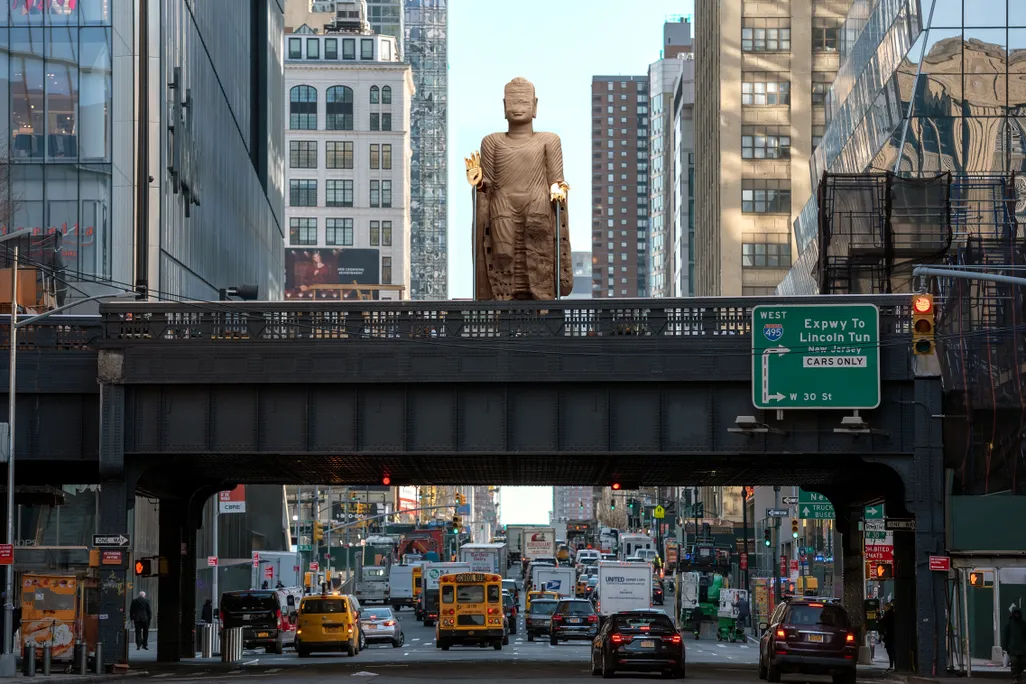When we think of dim sum, most of us think of rowdy banquet halls, packed full with hungry diners and delicacies like chicken feet, crystal shrimp dumplings and pork buns. I personally think of the Chinese expression “re nao” (热闹), which translates literally to “hot and noisy” — a sign (in Chinese minds) of a restaurant’s popularity and freshness.
All of this applies to one of my favorite New York dim sum parlors — which also happens to be the city’s oldest. From morning until night, Nom Wah Tea Parlor serves dim sum in a quaint, diner-like setting, replete with mahogany red banquettes and waiter service.
The establishment has changed hands several times over the course of more than a century, but its popularity has never waned, even as dim sum joints continue to saturate New York City. Under current owner Wilson Tang, Nom Wah adeptly juggles tradition and modernity much like Tang tries to do himself, “with one foot firmly placed in the past, and the other in the future.”
The Place
Nom Wah bills itself as New York’s oldest dim sum establishment — and for the most part, it has proudly retained its old-school appearance. New Yorkers and tourists alike have bought into the hype of eating in a scenic spot in which many Hollywood fantasies were filmed — The Amazing Spider-Man 2 and Premium Rush, to name recent examples. That partially accounts for the long lines that sprawl onto Doyers and Pell — the epicenter of Manhattan’s legendary Chinatown — every weekend.

Owner Wilson Tang — nephew of the previous proprietor, Wally Tang — didn’t spend a lot of time in Chinatown as a kid. But on the weekends he did, he fondly recalls “spinning on the barstools and snacking on goodies” while visiting the shop with his family.
Relinquishing a career in finance to run the restaurant, Wilson Tang says he wanted to “breathe life into this iconic restaurant” and help spread the gospel of dim sum throughout the city.
Since its founding, Nom Wah has expanded to a few other locations within the US — and most recently, to the southern Chinese metropolis of Shenzhen, smack dab in the nation’s dim sum heartland. Situated in the city’s Nanshan District, overlooking the bay, the Shenzhen outpost exemplifies the curious cross-national pollination that makes Chinese food so widely loved — and so widely varied.
Related:
 An Illustrated Guide to Chinese DumplingsFrom soup to rice, here’s a handy guide to the most popular types of Chinese dumplingsArticle Jul 25, 2019
An Illustrated Guide to Chinese DumplingsFrom soup to rice, here’s a handy guide to the most popular types of Chinese dumplingsArticle Jul 25, 2019
Wilson Tang agrees. “When I travel, I love seeing how people have interpreted or adapted recipes for their locale. Expanding to China was a riff on that idea. I’m sharing a culture within a larger culture, letting them in on my experience as a Chinese-American through food.”
But would Chinese diners actually enjoy a Chinese-American take on the regional cuisine they’re known for? It seems that way; Shenzhen’s Nom Wah boasts largely favorable reviews on Chinese review site Dianping.
The History
Over in New York, Nom Wah dates back to the 1920s, although even the current owners aren’t sure who its original founders were. But we do know that it was first opened as a bakery popular for its mooncakes, at what was then one of the most dangerous intersections in Chinatown.
“During the late nineteenth and early twentieth centuries, New York’s Chinatown was infamous for its warring tong wars — gang wars, basically,” explains Wilson Tang. “When Nom Wah opened in 1920, these gang fights were still fervently happening.” He explains that their corner of Doyers Street was nicknamed “The Bloody Angle,” since the street pivots almost 90 degrees, making it a choice spot for surprise attacks.
The Choy family operated Nom Wah from the 1940s onwards before eventually selling it to Wally Tang — Wilson’s uncle — in 1974. Tang the elder was a long-time employee who worked his way up from dishwasher at age 16 to manager in only a couple of years. He spearheaded Nom Wah’s transformation from bakery to dim sum restaurant, before eventually passing ownership onto his nephew in 2010.

Image: Lia Chang, Museum of Chinese in America
The Cantonese tradition of dim sum long predates the 100+ year old restaurant, however. And as Cantonese cuisine more widely dispersed across US cities during the 20th century, dim sum restaurants like Nom Wah have become a frequent pit stop among many a savvy American diner, even outside the Chinese community.
The Food
The exact time in history that dim sum (or 点心 dianxin in Mandarin) originated is debatable, but it’s without question that southern China, specifically Guangdong province, is where it became what it is today. A dim sum brunch — circling the tradition of yum cha, or tea drinking — typically consists of small bites like dumplings, rolls and side dishes. And as southern Chinese immigrants moved to US cities, opened their own businesses, and began adapting to local ingredients and tastes, some the dishes gained distinctly Chinese-American characteristics of their own.
Nom Wah’s menu reflects that precise blend of Chinese and Chinese-American. It serves traditional dishes such as chicken feet that — while they might raise some eyebrows — are considered a delicacy in China. And they are indeed delicious — when done right. “They’re pure flavor, and when made correctly, the skin falls right off the bone,” attests Wilson Tang, who counts the dish as one of his personal favorites. “Plus, chicken feet are high in collagen.”
However at any dim sum restaurant worth its salt, it’s the dumplings that demand center stage. Part of dim sum’s charm is the jewel-like bites that each delicacy offers. Nom Wah’s shrimp and snow pea leaf dumplings are a must-order for that reason — perky shrimp paired with crisp snow pea leaves so light and refreshing, it’s hard to resist devouring a basket of them all by yourself.

Shrimp and snow pea leaf dumplings
Nom Wah does mix things up by trading in the traditional trio of pork buns for a super-sized edition (pictured at top) — a variation that Wally Tang first introduced to the menu. We admittedly were skeptical of the dough-to-meat ratio, but found the marinated pork and onions to be gooey, meaty and tender, wrapped up in a doughy bun that doesn’t lose its chewy plumpness despite its XXXL size.
It’s always a challenge to keep a long-standing business from becoming a relic of the past. But balancing past and present is something Nom Wah does beautifully — by putting a spin on the classics, while also introducing curious diners to Chinese culture through some of its most beloved dishes.
All images: Paul Wagtouicz unless otherwise stated.

















